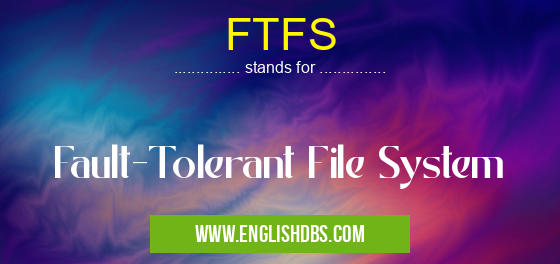What does FTFS mean in DATABASES
Fault-Tolerant File Systems (FTFS) are an important advancement in data storage and processing technology. Fault-tolerance refers to the ability of a system or program to continue functioning despite the presence of errors or faults in the software, hardware, or environment that could potentially cause it to fail. This is especially important in mission-critical applications where downtime can cost organizations time, money, and customer loyalty. With FTFS, businesses can make sure their data remains safe, even if any component of their system fails.

FTFS meaning in Databases in Computing
FTFS mostly used in an acronym Databases in Category Computing that means Fault-Tolerant File System
Shorthand: FTFS,
Full Form: Fault-Tolerant File System
For more information of "Fault-Tolerant File System", see the section below.
Definition
An FTFS is a file system designed with fault-tolerance at its core to enable continued operation even if one or more components (software, hardware or environment) fail. Fault tolerance is achieved through careful design and implementation of methods such as redundancy, replication, isolation and virtualization which allow for alternate paths for information transfer in case of a failure in one component.
Benefits
FTFSs provide many benefits to businesses who depend on them for their day-to-day operations. Not only do these systems offer high availability and reliability by shielding critical functions from being disrupted by technical outages and errors; they also provide advanced features such as data mirroring and fault detection that help ensure the integrity of stored information while ensuring rapid recovery times in case something goes wrong. Moreover, FTFSs can be tailored to suit different needs within an organization by leveraging distributed computing techniques making them applicable across multiple industries and areas of application.
Essential Questions and Answers on Fault-Tolerant File System in "COMPUTING»DB"
What is Fault-Tolerant File System?
Fault-tolerant file systems are designed to keep data safe even when components fail. They provide redundancy and continuous access to data, allowing users to continue working without interruption even if part of the system fails. The main goal of fault-tolerance is to ensure that data is not lost due to a hardware or software issue.
How does a Fault-Tolerant File System work?
A fault-tolerant file system works by creating multiple copies of data across different nodes in a network. This allows the system to continuously access data, even if one node fails due to an error or crash. The system also checks the integrity of each copy and can repair any errors that are encountered during transfers or reads.
What is the importance of Fault Tolerance?
Fault tolerance is critical for ensuring that mission-critical applications and systems remain operational despite hardware or software issues. Without fault tolerance, applications and systems could suffer service disruption or even permanent loss of data which would be catastrophic for any business environment.
What kind of redundancy does a fault tolerant file system provide?
Fault tolerant file systems typically use redundant arrays of independent disks (RAID) technology to create multiple copies of data on different nodes in order to better ensure its survival should one node fail or become unavailable due to an issue. By using RAID technology, organizations can ensure that their mission-critical applications will remain operational and protected against potential data loss scenarios.
How often should you check the integrity of your fault tolerant file system?
It's important to regularly monitor your fault tolerant file system, including checking the integrity of each copy against all other copies at least once per day or sooner, depending on usage and load requirements. Regular monitoring will help identify any potential problems before they become too severe, allowing you to respond quickly with corrective action as needed.
Are there any limitations with a fault tolerant file system?
Yes, there are some limitations with a fault tolerant file system — most notably, it may not be able to recover from certain types of causes such as malicious attacks or natural disasters that cause physical damage beyond its ability (i.e., earthquakes). Additionally, you may experience longer downtimes than usual if too many nodes fail within a given time period as the network struggles to reassemble itself around available intermediary nodes.
Is it possible for me store my backups offsite with a fault tolerant file system?
Yes, most fault tolerant file systems support offsite storage by using cloud storage services such as Amazon S3 or Microsoft Azure Storage Services which allow you store your backups in another location away from your primary site and still maintain access when needed.
Does a fault tolerant file system protect me against ransomware attacks?
While no protection is ever 100% secure against ransomware attacks, having redundant copies stored on different servers makes it much more difficult for attackers gain control over all copies thus reducing their chances significantly compared what would otherwise occur had you relied solely on backups stored on one server only.
Are there any tools I need in order to setup my own fault tolerant filesystem?
You'll need appropriate hardware such as servers where you can install operating systems capable supporting RAID technology; most common ones being Windows Server 2016/2019 and Red Hat Enterprise Linux 7/8 which include all necessary capabilities out-of-the box but depending on setup complexity additional software might be required as well.
Final Words:
In conclusion, Fault Tolerant File System (FTFS) represent an important advancement in data storage technology that provides unparalleled reliability and resilience against any potential issues caused by technical malfunctions or other external factors. By using this type of system organizations can rest assured that their critical operations won't suffer interruptions due to outages thus ensuring continuous productivity and customer satisfaction.
